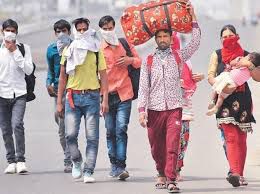Efficacy of Collective Bargaining and Worker/s Association
Trade Unions were first formed in India in the early 19th century and were
later regulated through the Trade Union Act, of 1926 to provide protection to
such unions. In India, currently, INTUC (Indian National Trade Union Congress)
currently affiliated with Indian National Congress and BMS (Bhartiya Mazdoor
Sangh) affiliated with Bhartiya Janta Party are considered the biggest trade
unions. Key Developments of the 19th century include the formation of the Bengal
Trade Union Federation (1922), All India Railwaymen Federation (1922) and the
All-India Trade Union Congress (1920).
Supreme Court defines Collective Bargaining as "the technique by which dispute as to the condition of employment is resolved amicably by agreement rather than coercion". It is a 6-stage process that begins with negotiation between the workers and the employers, here workers are expressed by the representatives of trade unions. According to the Industrial Dispute Act, of 1947, if a worker denies the process of collective bargaining in good faith, it will be considered as an unfair labour practice.
Trade Union plays an important role when workers are engaging in collective bargaining due to this every worker in the industry have a right to form and register a trade union and this has been upheld by courts in many cases.
Collective Bargaining Stages
Types of Collective Bargaining:
Levels of Collective Bargaining
There are different levels on which collective bargaining can be done, these include:
Effectiveness of Collective Bargaining
Shortcomings of Collective Bargaining
Collective Bargaining Case Study
John Deere' employees in the year 2021 tried to make a negotiation with the agricultural equipment manufacturer to form a more favourable contract. But it was believed by the majority of the workers working there that they will be an increase in their wages and some will also receive increased retirement benefits than the original offer of the company because John Deere was receiving a higher amount of profit during the COVID-19 pandemic and their labour demands were also increased.
The first proposal made by John Deere was rejected by the workers of the company and they agreed to go on strike against the company. Workers started picketing the headquarters and factories of John Deere on 14thOctober 2021 but then lead to a worrisome situation for farm companies when they realised their ability to increase the harvest. When the pressure was built from the public, politicians and workers, John Deere finally met the demands of their workers and proposed a new contract. This to the end of the month of the strike on 17thNovember 2021.
Conclusion
In conclusion, collective bargaining is not only limited to fulfilling the needs of the workers, but it also helps in fulfilling the rights of the employers. Collective bargaining is not only a national concept but a term which has been recognized internationally by the International Labor Organization.
There are many advantages of Collective bargaining, and it should be considered that it is a voluntary step which usually ends with an effective negotiation between the parties. Though there are some disadvantages of Collective Bargaining overall, it is a successful concept. Judiciary also helps in providing aid to the parties if in case, the negotiations fail. For this purpose, National tribunals, Industrial Tribunals and Labor Courts have been formed on both centre and state levels for effective resolution.
References:
Supreme Court defines Collective Bargaining as "the technique by which dispute as to the condition of employment is resolved amicably by agreement rather than coercion". It is a 6-stage process that begins with negotiation between the workers and the employers, here workers are expressed by the representatives of trade unions. According to the Industrial Dispute Act, of 1947, if a worker denies the process of collective bargaining in good faith, it will be considered as an unfair labour practice.
Trade Union plays an important role when workers are engaging in collective bargaining due to this every worker in the industry have a right to form and register a trade union and this has been upheld by courts in many cases.
Collective Bargaining Stages
- Charter of Demands:
Trade union notifies employer for negotiations and representatives prepare a draft of the "charter of demands" which contains issues of workers like terms of employment, wages, working hours etc. In case of multiple unions, all unions must submit such a charter.
- Negotiations:
This is the next step after the submission of 'The Charter of Demands" where both employer and employee prepare by collecting data and strategies for negotiations. After preparation, both engage in discussions on the demands of the workers. If the demands are met by employers, they form an agreement but if the demand is rejected, the workers proceed with strike.
- Collective Bargaining Agreement:
When the demands of the workers are met a collective bargaining agreement is formed between workers and employers. Such agreement is in the form of a memorandum of settlement or bipartite agreement.
- Strike:
If parties fail to end the negotiations with an agreement, then the workers can engage in a strike for which a notice has to be given 14 days prior before going to strike. This period is known as the "cooling off" period.
- Conciliation:
During the "cooling off" period, conciliation takes place for which a conciliation board is appointed by the state government which consists of a chairman, and two to four representatives of employers and employees. After 7 days from conciliation, if no settlement is made, must the strike begin. At this time, reference to an industrial tribunal or labour court must be made.
- Adjudication or arbitration by Industrial Tribunal and Labor Court:
When conciliation fails, parties can go to voluntary arbitration where the centre or state government appoint a Board of Arbitrators for the parties or compulsory arbitration where a mutually agreed third party is referred to by both parties.
When conciliation fails, parties can go to voluntary arbitration where the centre or state government appoint a Board of Arbitrators for the parties or compulsory arbitration where a mutually agreed third party is referred to by both parties.
Section 7A of IDA, states that Industrial Tribunal or Labor Court must be formed in each state for adjudicating industrial disputes.
Section 7B states for the formation of a National Tribunal by the Center Government to adjudicate disputes which are related to the questions of national interests.
Types of Collective Bargaining:
- Composite Bargaining: In this, compensation is not the integral part rather it focuses on issues like job security, working conditions, and other corporate policies. The issues can be related to firing practices in the workplace. The primary purpose is to achieve a harmonious relationship between employers and employees.
- Concessionary Bargaining: It implies that the leaders of the trade union make concessions in exchange for job security and is a common practice in times of recession.
- Distributive Bargaining: This type of bargain focuses on favoring workers over employers. The employer has to give additional benefits to the workers like increased bonuses or salaries, or other financial benefits.
- Integrative Bargaining: A type of bargain that benefits both the employer and the employee and is also known as win-win bargaining. Each side considers the issues of the other party and comes to an agreement which benefits both sides.
- Productivity Bargaining: It focuses on increasing the productivity of the work done, the leaders of the union may increase the salaries or compensations to increase the value of the employee which, in turn, helps in increasing productivity.
Levels of Collective Bargaining
There are different levels on which collective bargaining can be done, these include:
- National- Level:
This is common within industries like coal, ports, docks, steel, oil, and bank where the employer is the Central Government. Here, a "coordination committee" is set up to engage in collective bargaining between the central government and workers.
- Industrial-cum-regional:
Here the domination is of the private sectors like jute, textiles, cotton, tea plantation, and engineering. Company-wide agreements and regional agreements are formed and are binding only if the employers' association mandates it in writing to make it binding on company management.
- Constitution of India
Article 19(I)(c) of Constitution: This article provides the fundamental right of "freedom of speech and expression" and it also guarantees the "right to form association and unions" to the citizens. This right includes the formation of trade unions. It was held in the case of Damyanti Naranga v. Union of India, that the right guaranteed under article 19(I)(c) consists of the "right to join association or union". But restrictions can be imposed on it by State government.
In All India Bank Employees' Association v. National Industrial Tribunal, the Supreme Court held that the "right to form union or association" does not include within it's ambit the duty that trade union so recognized must be a part of Collective Bargaining or achieve the purpose of its formation.
- Universal Declaration of Human Rights recognizes "freedom of
association" as a fundamental right. Settled under the rule of law and at
the heart of democracy it is marked as an enabling right that ensure
involvement in social and economic policy- making. For overall governance
structure and for labor markets it is important that voices of employers and
employees are heard. Article 2 of the Collective Bargaining Convention, 1981
defines the term "collective bargaining".
- For a free and open society, it is an integral part that the employees
and employers are join or form organization of their choices. "Freedom of
association" is promoted regularly by the International Labor Organization
as it advices the governments to make effective labor laws that provides
information for employers groups and trade unions.
- Reaffirmed by the ILO Declaration on fundamental Principles and Right at Work
and states under the ILO Constitution is the fundamental right of Collective
Bargaining which is issue closely linked to the "Freedom of Association". For
establishing fair working condition, fair wages and ensuring equal opportunities
between men and women, collective bargaining is a method adopted by the trade
union and workers and their organizations.
- Issues discussed on the Bargaining agenda typically involves,
occupational health and safety, training, wages, working time and equal
treatment. The target of these negotiations is to achieve at a mutually
agreed terms of employment and such terms are to be specified in the
agreement. Collective agreements also include the responsibilities and
rights of both the parties of the negotiations and thereby ensuring
increased productivity of industries. The pivotal part of including the
concept of collective agreements and collective bargaining is to extend
labor protection and reduce inequality in the member states.
- The founding principles of ILO are Collective Bargaining and Freedom of Association and for this purpose, the Right to Organize and Collective Bargaining Convention, 1949 and Freedom of Association and Protection of Right to Organize Convention, 1948 were introduced, along with this a committee was set up in 1951 by the ILO for resolving the complaints related to "freedom of association" and the committee was known as "Committee on Freedom of Association" (CFA).
Effectiveness of Collective Bargaining
- Collective Bargaining enhances workers' voices:
In an industry, workers may find it difficult to negotiate with employers related to the issues faced by them. Collective Bargaining acts as a systematic approach to negotiations where the trade union effectively represent workers. Because would such discussions, employers would take dominance over the workers giving them a "take it or leave it" offer which in turn can harm the working conditions of the workers.
- Improved Quality of Life:
Workers, if their demands are met, may get benefits which can help them and their families as such benefits could include higher income or medical benefits for a family. Even if the above is not provided the employers may improve the working conditions of the premises i.e., if the workers are working in any workplace which produces hazardous substances proper equipment like masks and gloves can be provided to the workers.
- Encourages Cooperation:
Negotiations give both parties a fair chance of being heard and state their own points. On one hand, the employees may be in need of fair wages or health benefits, or an environment fit for working. On the other hand, employers' demand for productivity and higher revenue generation could be met by such negotiations, if done in good faith.
- A Binding Award:
Since, collective bargaining is a result binding on both the parties it provides a much secure position of law, and such agreement compels the parties to adhere to the terms of it. If one of the parties is not performing their end of the agreement, they have to compensate for the damages caused to the other party.
Shortcomings of Collective Bargaining
- Uncertainty in Outcome:
Even after the formation of agreement it has been seen that the working conditions and conduct of employee was not improved much and there is also uncertainty while enforcing the agreement because there may be chances that one party fulfill their side of bargain while the other does not.
- Good Representation not always possible:
A member of trade union might have to pay some amount to the trade union for representation to get benefits, whereas a labor of the same industry and that is not a member of a trade union will also get those benefits if approved by the employers. Due to this methos, one group has to pay for representation while the other does not have to pay anything this leads to an unfair situation.
- Bounded under the Contract:
In some scenarios, it is also possible that the agreement might be applied to even those members of the industries which were not a part of the negotiations like administrators, and they might not be getting any actual benefit from such negotiation.
Collective Bargaining Case Study
John Deere' employees in the year 2021 tried to make a negotiation with the agricultural equipment manufacturer to form a more favourable contract. But it was believed by the majority of the workers working there that they will be an increase in their wages and some will also receive increased retirement benefits than the original offer of the company because John Deere was receiving a higher amount of profit during the COVID-19 pandemic and their labour demands were also increased.
The first proposal made by John Deere was rejected by the workers of the company and they agreed to go on strike against the company. Workers started picketing the headquarters and factories of John Deere on 14thOctober 2021 but then lead to a worrisome situation for farm companies when they realised their ability to increase the harvest. When the pressure was built from the public, politicians and workers, John Deere finally met the demands of their workers and proposed a new contract. This to the end of the month of the strike on 17thNovember 2021.
Conclusion
In conclusion, collective bargaining is not only limited to fulfilling the needs of the workers, but it also helps in fulfilling the rights of the employers. Collective bargaining is not only a national concept but a term which has been recognized internationally by the International Labor Organization.
There are many advantages of Collective bargaining, and it should be considered that it is a voluntary step which usually ends with an effective negotiation between the parties. Though there are some disadvantages of Collective Bargaining overall, it is a successful concept. Judiciary also helps in providing aid to the parties if in case, the negotiations fail. For this purpose, National tribunals, Industrial Tribunals and Labor Courts have been formed on both centre and state levels for effective resolution.
References:
- https://vittana.org/16-advantages-and-disadvantages-of-collective-bargaining
- https://www.nishithdesai.com/fileadmin/user_upload/pdfs/Research%20Papers/India-Trade-Unions-and-Collective-Bargaining.pdf
- https://www.ilo.org/wcmsp5/groups/public/---ed_norm/---normes/documents/publication/wcms_087931.pdf
- Udipti Chopra, student of Delhi Metropolitan Education, Noida affiliated by Guru Gobind Singh Indraprastha University, New Delhi
- Yashjeet Singh Mehta, student of Delhi Metropolitan Education, Noida affiliated by Guru Gobind Singh Indraprastha University, New Delhi
Law Article in India
Legal Question & Answers
Lawyers in India - Search By City
LawArticles
How To File For Mutual Divorce In Delhi

How To File For Mutual Divorce In Delhi Mutual Consent Divorce is the Simplest Way to Obtain a D...
Increased Age For Girls Marriage

It is hoped that the Prohibition of Child Marriage (Amendment) Bill, 2021, which intends to inc...
Facade of Social Media

One may very easily get absorbed in the lives of others as one scrolls through a Facebook news ...
Section 482 CrPc - Quashing Of FIR: Guid...

The Inherent power under Section 482 in The Code Of Criminal Procedure, 1973 (37th Chapter of t...
The Uniform Civil Code (UCC) in India: A...

The Uniform Civil Code (UCC) is a concept that proposes the unification of personal laws across...
Role Of Artificial Intelligence In Legal...

Artificial intelligence (AI) is revolutionizing various sectors of the economy, and the legal i...








Please Drop Your Comments